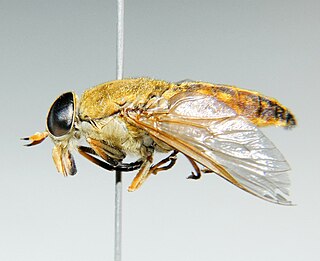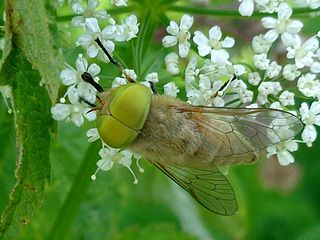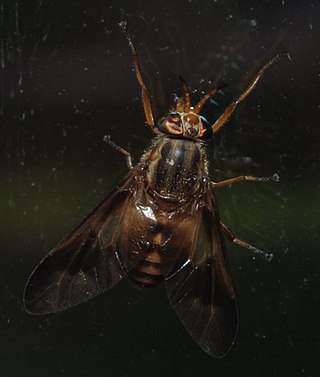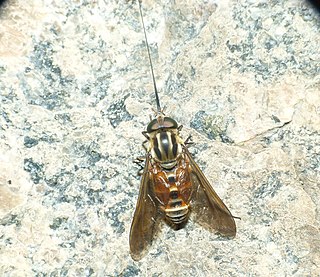
Tabanus nigrovittatus, also known as the greenhead horse fly, salt marsh greenhead, or simply the greenhead fly, greenhead or greenfly, is a species of biting horse-fly commonly found around the coastal marshes and wetlands of the Eastern United States. They are smaller than most horsefly species, instead being close in size to a common housefly. The biting females are a considerable pest to both humans and animals while they seek a source of blood protein to produce additional eggs: greenhead larvae develop in the mud of salt marshes, and adult flies mate and lay their first group of eggs in the marsh, but to lay more eggs a female fly needs to drink an animal's blood, and so female greenheads which have laid eggs fly inland to look for prey in the area bordering the marsh; they can stay on land looking for animals to bite for up to four weeks. Their bites are more painful than those of mosquitoes, since greenheads feed by cutting a wound in the skin with scissor-like mouth parts and sucking the blood released through it. Females live for three to four weeks and may lay about 100 to 200 eggs per blood meal. The eggs are laid on the grass in a salt marsh; the larvae live in the intertidal mud of the salt marsh for one or two years, preying on other invertebrates, before pupating in early spring. The adult flies emerge in late spring and are most common from late June to August.

Dichelacera is a genus of horse flies in the family Tabanidae.

Tabanus fulvulus is a horse fly in the subfamily Tabaninae, in the order Diptera ("flies").

Atylotus is a genus of horse flies in the family Tabanidae.
Tabanus fumipennis is a horse fly in the subfamily Tabaninae, in the order Diptera ("flies").
Hybomitra frontalis is a species of horse flies in the family Tabanidae.

Chrysops flavidus is a species of deer fly in the family Tabanidae. The species is identifiable by its yellow legs.
Atylotus bicolor is a species of horse fly in the family Tabanidae. The species typically breeds in freshwater marshes. Larvae can be found in bogs, swamps, or in the soil of a riparian zone.
Hybomitra lasiophthalma is a species of horse flies in the family Tabanidae.
Chrysops excitans is a species of deer fly in the family Tabanidae.

Chrysops vittatus is a species of deer fly in the family Tabanidae.

Philoliche is a genus of long-tongued Horse-flies found in the Old World. It appears to be the sole member of tribe Philolichini.

Pangoniinae is a subfamily of horse-flies in the order Diptera, containing at seven tribes and over 40 genera.
Pityocera is a genus of flies in the family Tabanidae.
Fidena is a genus of horse-fly in the tribe Scionini.
Hybomitra zonalis is a species of horse flies in the family Tabanidae.
Phaeotabanus is a genus of horse flies in the family Tabanidae.
Catachlorops is a genus of horse flies in the family Tabanidae.
Stenotabanus taeniotes is a species of horse flies in the family Tabanidae.








